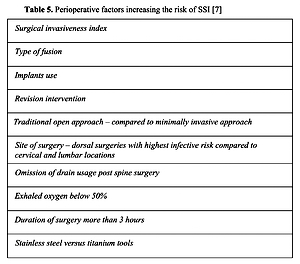Current issue
Archive
Manuscripts accepted
About the Journal
Editorial office
Editorial board
Section Editors
Abstracting and indexing
Subscription
Contact
Ethical standards and procedures
Most read articles
Instructions for authors
Article Processing Charge (APC)
Regulations of paying article processing charge (APC)
NEUROSURGERY / RESEARCH PAPER
Infections and antibiotic therapy in patients after spine surgery in a 5-year follow-up study
1
Mazovian Rehabilitation Center STOCER, Department of Neuroortopeadics, Poland
2
The Faculty of Medicine of the Lazarski University, Poland
Submission date: 2021-02-23
Final revision date: 2021-06-09
Acceptance date: 2021-07-02
Online publication date: 2021-07-21
Corresponding author
Joanna Baranowska
Mazovian Rehabilitation Center STOCER, Department of Neuroortopeadics, Wierzejewskiego 12, 05-510, Konstancin Jeziorna, Poland
Mazovian Rehabilitation Center STOCER, Department of Neuroortopeadics, Wierzejewskiego 12, 05-510, Konstancin Jeziorna, Poland
KEYWORDS
TOPICS
ABSTRACT
Introduction:
Infections after spinal surgery are sporadic and depend on the patient's condition and the type and extent of surgery. The incidence of surgical site infections in European centers ranges from 0% to 18%. The aim of the study was to determine the frequency of infections in patients after spinal surgery.
Material and methods:
The analysis covered 6067 patients who underwent spinal surgery in the Department of Neuroorthopedics between 2015-2019, taking into account the number of microbiological tests and the number of detected infections, the number of surgical procedures and the rate of SSI infections, the number of readmissions and reoperations, and the use of antibiotics. The analysis was based on retrospective data of patients hospitalized in the analyzed period.
Results:
The number of operated patients remained at a similar level in the analyzed annual periods, from 1136 to 1269 patients, while the infection rate of the operated site ranged from 0,33% to 1,04%, and the percentage of infections was between 0,58% and 3,29 %. In turn, the analysis of reoperations performed due to infection of the operated site in 2018 and 2019 was 0,56% and 0,07%, respectively, which places the center in the leading position in the European ranking. During the analyzed five years, the use of antibiotics was reduced by 2/3.
Conclusions:
The analysis of infections in patients after spinal surgery over a 5-year period showed that the SSI rate did not exceed 1,04%, which is comparable with data from recognized European centers. Infections caused by alarm pathogens have been detected occasionally.
Infections after spinal surgery are sporadic and depend on the patient's condition and the type and extent of surgery. The incidence of surgical site infections in European centers ranges from 0% to 18%. The aim of the study was to determine the frequency of infections in patients after spinal surgery.
Material and methods:
The analysis covered 6067 patients who underwent spinal surgery in the Department of Neuroorthopedics between 2015-2019, taking into account the number of microbiological tests and the number of detected infections, the number of surgical procedures and the rate of SSI infections, the number of readmissions and reoperations, and the use of antibiotics. The analysis was based on retrospective data of patients hospitalized in the analyzed period.
Results:
The number of operated patients remained at a similar level in the analyzed annual periods, from 1136 to 1269 patients, while the infection rate of the operated site ranged from 0,33% to 1,04%, and the percentage of infections was between 0,58% and 3,29 %. In turn, the analysis of reoperations performed due to infection of the operated site in 2018 and 2019 was 0,56% and 0,07%, respectively, which places the center in the leading position in the European ranking. During the analyzed five years, the use of antibiotics was reduced by 2/3.
Conclusions:
The analysis of infections in patients after spinal surgery over a 5-year period showed that the SSI rate did not exceed 1,04%, which is comparable with data from recognized European centers. Infections caused by alarm pathogens have been detected occasionally.
We process personal data collected when visiting the website. The function of obtaining information about users and their behavior is carried out by voluntarily entered information in forms and saving cookies in end devices. Data, including cookies, are used to provide services, improve the user experience and to analyze the traffic in accordance with the Privacy policy. Data are also collected and processed by Google Analytics tool (more).
You can change cookies settings in your browser. Restricted use of cookies in the browser configuration may affect some functionalities of the website.
You can change cookies settings in your browser. Restricted use of cookies in the browser configuration may affect some functionalities of the website.



